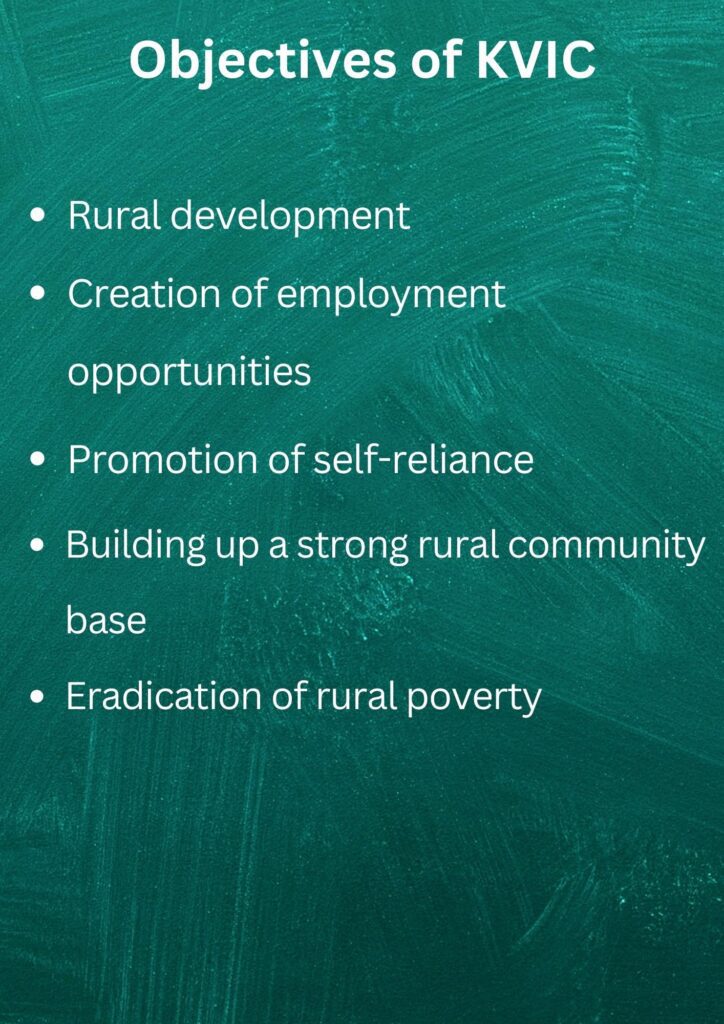Khadi Village Industries Commission (KVIC) is a statutory organization. It was established in April 1957, and the Khadi and Village Industries Act of 1956 was passed by the Parliament. It is engaged in promoting Khadi and village industries to create employment opportunities in rural areas.
The All India Khadi and Village Industries Board, established in 1953, was surpassed by its successor. It supports micro units. During India’s fight for independence, Mahatma Gandhi’s vision of rural self-sufficiency and economic autonomy served as the inspiration behind its creation. Gandhian philosophy and thought are the backbone of KVIC’s policy.
Objectives of KVIC

The Khadi Village Industries Commission (KVIC) has mainly 5 objectives to promote and develop rural industries in India.
There are several objectives of KVIC. They are :
- Rural development through rural industrialization
- Creation of employment opportunities in rural areas
- Promotion of self-reliance among people
- Building up a strong rural community base
- Eradication of rural poverty
Functions of KVIC
KVIC has several key roles to play. The primary functions of KVIC are as follows:
- To plan and organize training programs for potential entrepreneurs (i.e., to train rural artisans)
- To supply raw materials at reasonable rates
- To promote marketing and sale of khadi products of village industries and handicrafts To explore the possibilities of exports of KVIC products
- To offer advice for the recovery of struggling businesses.
- To provide financial support to eligible individuals and institutions
- To undertake research and development programs to enhance the productivity of rural workers and artisans
Role of KVIC in the Indian Economy
KVIC plays a vital role in the Indian economy by focusing on empowering rural communities:
- Creating Jobs: KVIC creates sustainable employment opportunities in traditional industries like hand-spinning, weaving, pottery, and more, providing income and livelihood security for millions in rural India.
- Supporting Entrepreneurs: KVIC helps individuals and communities establish small-scale businesses by offering financial assistance, skill training, technical support, and access to markets.
- Empowering Marginalized Groups: KVIC prioritizes marginalized communities, including women, tribal groups, and economically disadvantaged individuals, promoting inclusive growth and socioeconomic empowerment.
- Preserving Heritage: KVIC safeguards India’s rich tradition of crafts and artisanal skills, ensuring these cultural practices are passed down to future generations.
- Promoting Sustainability: KVIC promotes environmentally friendly practices, using natural resources and traditional production methods to align economic growth with environmental sustainability.
- Strengthening Rural Economies: Through job creation, entrepreneurship support, and empowerment of rural populations, KVIC contributes to a more self-sufficient rural economy, reducing poverty and bridging the economic gap between rural and urban India.
Khadi and its Importance in India
Khadi’s significance in India goes beyond just being a type of fabric. It has historical and philosophical value:
- Symbol of Independence and Self-Reliance: Mahatma Gandhi supported Khadi as part of the Swadeshi movement during India’s fight for freedom. Khadi represented economic independence and resistance against British textiles. Spinning Khadi became a symbol of defiance and national pride.
- Empowering Rural Communities: After independence, Khadi became linked with the growth of rural economies. It still supports many artisans and encourages entrepreneurship in villages all over India.
- Environmental Sustainability: The traditional methods used to make Khadi are eco-friendly and sustainable. They involve natural materials, low energy usage, and waste reduction.
- Preserving Cultural Heritage: Khadi production showcases centuries-old skills and craftsmanship. Promoting it helps protect these important aspects of India’s cultural heritage.
Khadi in Today
While Khadi has historical and symbolic significance, it is also adapting to modern times as a contemporary textile. Its eco-friendly qualities and the uniqueness of handmade fabrics are attracting more and more conscious consumers in India and around the world. The Govt of India is focusing on the development of Khadi.
Schemes and Initiatives
- The Prime Minister’s Employment Generation Programme (PMEGP)
- The Khadi Gramodyog Vikas Yojana (KVVY)
- Khadi Vikas Yojana (KVY)
- Gramodyog Vikas Yojana (GVY)
- SFURTI (Scheme of Fund for Regeneration of Traditional Industries)
- The Pradhan Mantri Jan Dhan Yojana (PMJDY)
- The Market Promotion and Development Scheme (MPDS)
The Prime Minister’s Employment Generation Programme (PMEGP): is a scheme run by KVIC at the national level to create job opportunities in rural areas by helping unemployed youth and aspiring entrepreneurs start new businesses. It offers financial aid for setting up micro-enterprises in various sectors.
The Khadi Gramodyog Vikas Yojana (KVVY): includes the Khadi Vikas Yojana (KVY) and Gramodyog Vikas Yojana (GVY). KVY focuses on Khadi industry development, while GVY promotes village industries other than Khadi. It provides financial support for infrastructure, working capital, and marketing of Khadi and village industry products.
SFURTI (Scheme of Fund for Regeneration of Traditional Industries): aims to assist traditional industries in their revival, modernization, and marketing efforts. It aids in cluster development, infrastructure improvement, skill enhancement, and market promotion for traditional industries.
The Pradhan Mantri Jan Dhan Yojana (PMJDY): RuPay Debit Card Scheme for KVIC Artisans provides RuPay debit cards to KVIC artisans connected to their Jan Dhan accounts, enabling digital transactions and financial inclusion.
The Market Promotion and Development Scheme (MPDS): offers financial aid for participating in exhibitions, fairs, and marketing events to promote Khadi and village industry products. It also supports branding and packaging initiatives for these products.
Progress and Achievements of KVIC
- KVIC has created jobs for more than 1.15 crore people in rural India as of March 2023. Between 2014-15 and 2022-23, over 83.54 lakh new jobs were generated through the PMEGP scheme alone.
- The production value of Khadi and village industry products has surged under KVIC’s initiatives, reaching ₹8.8 lakh crore in 2022-23, a 191% increase since 2014-15. Sales of Khadi have also soared to ₹1 lakh crore in 2021-22, showing a 332% increase from 2014-15.
- KVIC focuses on empowering weaker sections of society, with over 40% of beneficiaries belonging to Scheduled Castes, Scheduled Tribes, and other minorities as of March 2023.
- KVIC promotes eco-friendly practices in Khadi and village industries, emphasizing traditional hand-based production processes that contribute to environmental sustainability by using natural resources efficiently and reducing waste.
Mission of KVIC Organization
| Organization | Mission | Focus |
|---|---|---|
| KVIC | Take charge of KVIs development and relieve government complexities. | Streamline processes, allocate resources efficiently, and manage KVIC operations. |
| Community | Empower rural communities for security in lives and livelihoods. | Prioritize activities for rural well-being, including skill development and access to resources. |
| Village Industry | Increase productivity and competitiveness of KVI sectors. | Implement strategies for production improvement and technological advancements. |
| Market | Protect the socio-cultural value of Khadi and Village Industries as national asset. | Promote KVI products through exhibitions, online platforms, and partnerships. |
| Heritage | Protect the socio-cultural value of Khadi and Village Industries as a national asset. | Safeguard traditional knowledge, skills, and heritage associated with KVIs. |
Type of Commission and Concerned Ministry
The Khadi and Village Industries Commission (KVIC) is an important organization established by the Khadi and Village Industries Act of 1956. It is a legal body with specific powers and responsibilities outlined in the law.
Statutory Body:
- One of the key aspects of KVIC is that it operates as a statutory body, meaning it has the authority to carry out its functions as defined by the Khadi and Village Industries Act.
- This ensures that KVIC has a clear mandate and can effectively work towards its objectives.
Administrative Oversight
- It’s important to note that KVIC does not function independently. It operates under the administrative oversight of the Ministry of Micro, Small, and Medium Enterprises (MSMEs).
- The MSME Ministry provides guidance on policies, allocates resources, and monitors KVIC’s performance. This ensures that KVIC is accountable and working in line with the government’s objectives.
National Objectives
- The activities of KVIC are aligned with broader national goals, such as rural development, employment generation, and sustainable industrial growth.
- By focusing on these objectives, KVIC contributes to the overall development of the country and helps create opportunities for people in rural areas.
Overall, KVIC plays a crucial role in promoting rural industries and contributing to the growth and development of the nation.
Conclusion
In summary, the objectives of KVIC with India’s quest for self-reliance, rural prosperity, and the preservation of its diverse cultural heritage. By empowering local communities and celebrating traditional craftsmanship, KVIC continues to shape India’s socio-economic landscape.
Frequently Asked Questions
What are the primary objectives of KVIC?
The primary objectives of KVIC include rural development, job creation, promotion of self-reliance, building a strong rural community, and eradicating rural poverty.
How does KVIC contribute to the Indian economy?
KVIC contributes to the Indian economy by creating jobs, supporting entrepreneurs, empowering marginalized groups, preserving cultural heritage, and promoting sustainability.
What are some of the key functions of KVIC?
Some key functions of KVIC include organizing training programs, providing access to raw materials, promoting the marketing and sale of Khadi products, offering financial support to entrepreneurs, and conducting research and development initiatives.











Leave a Review